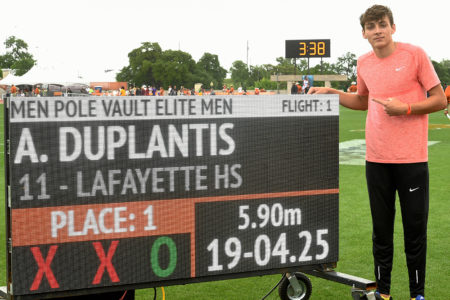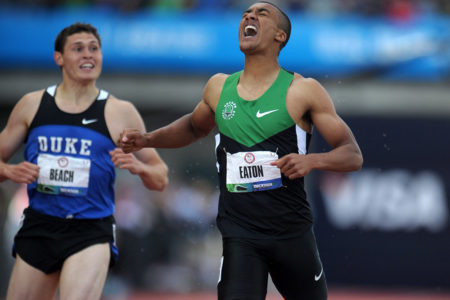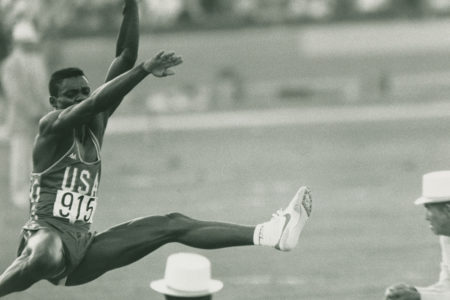 I LOVE THE FACT that the wheels keep turning in Monaco. The IAAF recognizes the fact that track is having a hard time maintaining its popularity in the modern sports world, and is doing things to try to remedy that problem. The question is, however, are they being innovative in the right places?
I LOVE THE FACT that the wheels keep turning in Monaco. The IAAF recognizes the fact that track is having a hard time maintaining its popularity in the modern sports world, and is doing things to try to remedy that problem. The question is, however, are they being innovative in the right places?
Elsewhere in this issue you’ll find some details on the proposed new multi-event scoring protocol, the Gundersen Method, and on the invention of a pair of brand-new events for the World Relays.
The intent of the former setup is certainly a noble one, the rationale being that fans would get more out of the women’s heptathlon 800 and men’s decathlon 1500 finish if the first across the line in those races were by definition the winner of the overall event. We’ll have to wait to see it in action before any real judgments can be made, of course, but going in I’m haunted by images of runners being strung out all over the track with there infrequently being any competition at all. I fear it will present even worse than the current methodology. I’d certainly like to see it experimented with in real competition somewhere before it’s rolled out, as planned, at a meet as major as the ’20 World Juniors (U20).
As to part the second, I’m not sure what the intent of the new relay events is, unless it’s change just for change’s sake. Color me not remotely a fan of a shuttle hurdles relay (be it same-sex or mixed). Figuring out when the “exchange” takes place has always seemed problematic at best, with different meets having different rules. (Full disclosure: I also dislike the event because I ran in one once, in high school, lost my steps after the first barrier and then put on one of the most laughable displays of hurdle-hopping ever.)
The 2x2x400 seems quite the curiosity, what with each of the two runners running twice. As our news bit says, if nothing else, it’ll be an interesting interval workout. Perhaps the most interesting part will take place far from the eyes of any fans, as teams try to figure out who can put together a pair of fast 400s with about a minute in between. Is it a pure 400 runner or a dedicated 800 type? Or is it somebody (think Martin McGrady from days of yore) for whom 600 skills might be perfect?
I guess if I were choosing an all-star team for this adventure, my guy would be Emmanuel Korir, with 44.21(A) speed and 1:42.05 endurance. Can he break 50 twice with a minute’s rest? How about a pair of 48s? The women’s choice would surely be double-World Ranked Caster Semenya (49.62/1:54.25). Can she do a pair of sub-55s?
Last year, the IAAF also got creative with the Continental Cup. Personally, I give the innovations there—strange cut-downs in the field events, with by-region rules, devil-take-the-hindmost races—a big fat F.
Coincidentally enough, it was at the preceding Continental Cup (Marrakech ’14) that the IAAF did attempt to address a real problem; that of uniforms and athlete ID. They put together a taskforce to look into the issue—and I was part of it, along with broadcasters, shoe company and athlete reps, IAAF staff—that met for 2 days to discuss the problem of similar kits and how they made it so hard for fans/broadcasters/announcers alike to follow who was who. We’re now 4-plus years down the road and as far as I can see, no closer to an answer.
One thing I suggested at that meeting was better usage of digital technology, and if any part of everyday life has improved a quantum amount since then, it’s what chips are doing for us. If other sports (sailing, auto racing, skiing) can do it, why doesn’t every major-meet telecast have the capacity to tag every runner in the field and call up an ID on the important ones as needed? If a big-name competitor is buried deep in the pack somewhere, they should be instantly taggable so viewers have a no-mistake visual.
And there’s so much more that could be done with splits, although I do recognize the fact that the sport can sometimes become too daunting if would-be fans are drowned in numbers. But digital technology could/should also be used to sort things out in races where staggers make things hard to sort out, sometimes even for experienced watchers of the sport. Wouldn’t it be nice to know what the order of placing (and differential) is at the 100, 200 & 300 points of a 400? How about knowing what’s up at each hurdle in the 400H?
Another major problem that gets ignored is how “parallax” affects one’s perception in that ultra-showcase event, the 100. Have you ever noticed that when you watch a dash up the straightaway on TV that the people in lanes 5–8 somehow regularly surge in the second half to pull even with those in 1-4? They’re not, of course, but the placement of the camera fools you into thinking so. Chips could help, but guess what, this one is an easy fix requiring no technology at all, unless you’re confused by a tape measure and a roll of tape. Simply put lines across the track at 25, 50 & 75m. You then stand a real chance at figuring out for yourself who’s really ahead and who isn’t. (Yes, I bounced this one off the IAAF once and was told, “There are too many lines on the track already.”)
The IAAF has a lot of fine minds, and they most definitely have improved the sport in recent years. Still, I’d like to see them thinking about ways to improve the basic product rather than coming up with what I fear are just gimmicks. □






